Review: Pioneer AVH-W4400NEX receiver proves wireless CarPlay is the way to go
The Pioneer AVH-W4400NEX is a phenomenal aftermarket car stereo head unit that bakes in wireless CarPlay and much more. AppleInsider takes you for a ride to check it out.
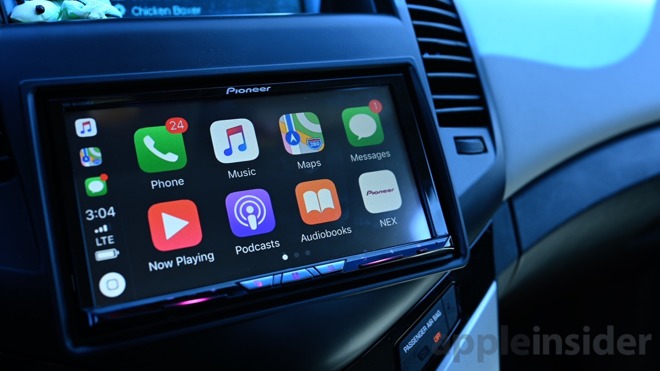
Pioneer AVH-W4400NEX
We've waited eagerly for wireless CarPlay to catch on amongst auto manufacturers, but they've continued to release new vehicles with a physical tether. This led us to pursue aftermarket solutions to this issue, of which there are now several.
The Pioneer AVH-W4400NEX was our first head unit of choice and we quickly had it installed in our Chevy Cruze. The installation didn't take long -- though easily outside our scope of car knowledge. Our vehicle wasn't particularly new, which means not all features of the unit were able to be taken advantage of, such as the dual camera inputs.
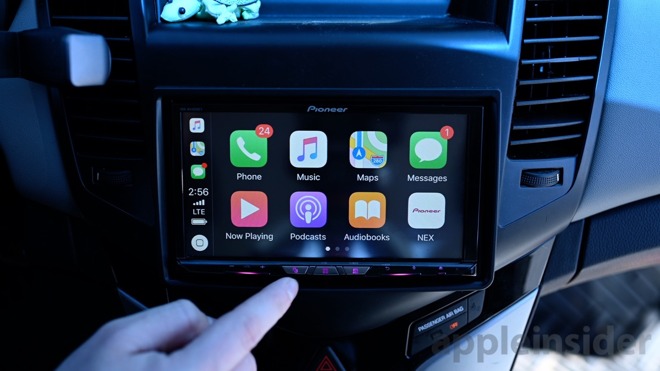
Pioneer AVH-W4400NEX
There are a few physical controls along the bottom of the unit to navigate to the splash screen as well as to control volume and other minor controls. From the splash screen, you can jump into any number of different functions. The shortcut bar on the bottom can be customized with several of your favorite shortcuts such as for Sirius XM, USB audio, and others.
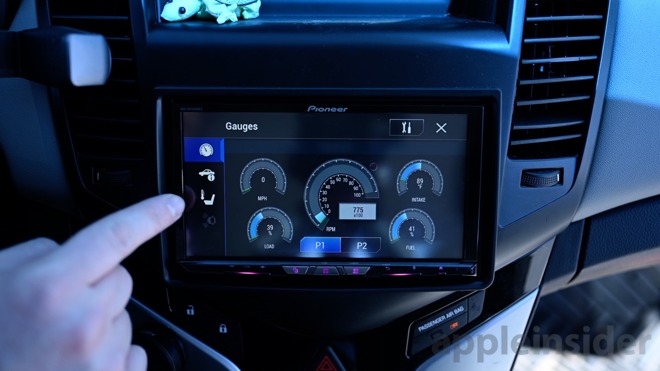
Pioneer AVH-W4400NEX with car guages
In our Chevy Cruze, much vehicle information was also readily available on this head unit. We could view our climate control, tire pressures, and which doors were open. Gauges also displayed our speed, RPM, fuel, and much more. Different vehicles will have different car stats available.
Some prefer capacitive displays rather than the resistive found here, but we had no qualms with its responsiveness. Each touch was always recognized and the matte finish reduces the glare from the sun while driving. We also didn't have to press the screen with any amount of notable force in order for it to register.
Our iPhone automatically found the receiver and paired on first setup. Once set up, each time we got in the vehicle it would connect and resume our audio where we left off previously. Occasionally, our iPhone did seem to be slightly confused when the vehicle shut off and we were on a phone call and took a few moments to correctly route the audio back to the earpiece -- a problem our wired CarPlay system hasn't encountered.
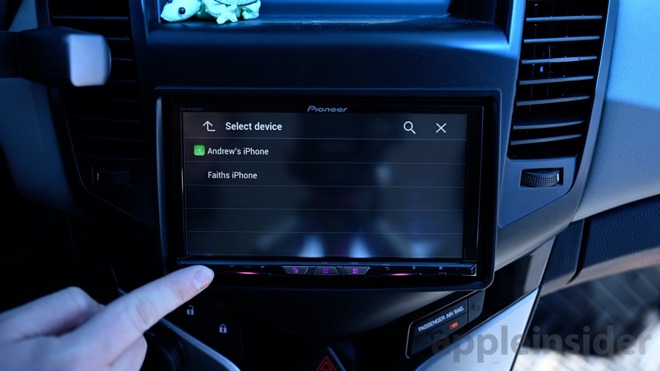
Pioneer AVH-W4400NEX swapping controlling devices
For us, we have two different iPhones we use with CarPlay and luckily it is easy to move between the two. From the main splash screen, our device can be tapped which opens the CarPlay menu. Here we can see both connected phones and choose which one is broadcasting to the unit. My phone was first on the list, so when both devices are in the car it is the one that connects by default.
Inside of the CarPlay interface, everything looks great. Which is, of course, the part designed by Apple. The rest of the UI though does feel a bit dated and clunky. You only have to rarely use it luckily, but when you do the experience is slightly jarring from the clean lines of Apple's design.
When using CarPlay, we saw next to no issues being wireless over wired. The CarPlay interface itself had no lag while navigating or responding to us opening/closing apps.
There was about a one second delay when controlling audio, however. When we would tap play/pause on our iPhone, the screen would recognize the change immediately and show it as such on the display, but the audio would be just a hair behind the visual change. It wasn't bothersome but it was noticable. That is the only "issue" we really experienced and find the wireless capabilities far outweigh that minor niggle.
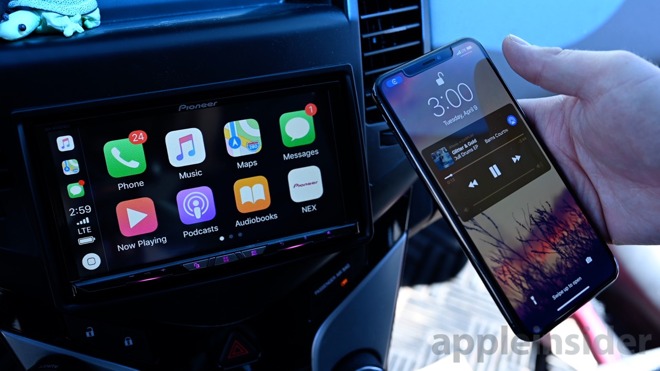
Pioneer AVH-W4400NEX wireless CarPlay
By going with wireless CarPlay, we were finally able to go with a wireless car charger as well. We love using something like the iOttie iTap to charge our phone just by placing it down rather than having to hook up any cable. Going wireless does drain battery compared to being wired, but by coupling it with a Qi car charger you get the best of both worlds.
If you are picking up a new car, you may not have an option for wireless CarPlay. If you have an existing vehicle that can be outfitted with a new head unit, the convenience makes it an easy choice.

Pioneer AVH-W4400NEX
We've waited eagerly for wireless CarPlay to catch on amongst auto manufacturers, but they've continued to release new vehicles with a physical tether. This led us to pursue aftermarket solutions to this issue, of which there are now several.
The Pioneer AVH-W4400NEX was our first head unit of choice and we quickly had it installed in our Chevy Cruze. The installation didn't take long -- though easily outside our scope of car knowledge. Our vehicle wasn't particularly new, which means not all features of the unit were able to be taken advantage of, such as the dual camera inputs.
A great head unit
This receiver is a double-din unit with a 7-inch resistive touchscreen with a matte finish and a resolution of 800 by 400. It supports both wireless CarPlay and wireless Android Auto. There is a wealth of configurable options such as backgrounds, color schemes, and immense audio EQ adjustments.
Pioneer AVH-W4400NEX
There are a few physical controls along the bottom of the unit to navigate to the splash screen as well as to control volume and other minor controls. From the splash screen, you can jump into any number of different functions. The shortcut bar on the bottom can be customized with several of your favorite shortcuts such as for Sirius XM, USB audio, and others.

Pioneer AVH-W4400NEX with car guages
In our Chevy Cruze, much vehicle information was also readily available on this head unit. We could view our climate control, tire pressures, and which doors were open. Gauges also displayed our speed, RPM, fuel, and much more. Different vehicles will have different car stats available.
Some prefer capacitive displays rather than the resistive found here, but we had no qualms with its responsiveness. Each touch was always recognized and the matte finish reduces the glare from the sun while driving. We also didn't have to press the screen with any amount of notable force in order for it to register.
CarPlay
Our biggest reason for picking up the AVH-W4400NEX was for the wireless CarPlay abilities.Our iPhone automatically found the receiver and paired on first setup. Once set up, each time we got in the vehicle it would connect and resume our audio where we left off previously. Occasionally, our iPhone did seem to be slightly confused when the vehicle shut off and we were on a phone call and took a few moments to correctly route the audio back to the earpiece -- a problem our wired CarPlay system hasn't encountered.

Pioneer AVH-W4400NEX swapping controlling devices
For us, we have two different iPhones we use with CarPlay and luckily it is easy to move between the two. From the main splash screen, our device can be tapped which opens the CarPlay menu. Here we can see both connected phones and choose which one is broadcasting to the unit. My phone was first on the list, so when both devices are in the car it is the one that connects by default.
Inside of the CarPlay interface, everything looks great. Which is, of course, the part designed by Apple. The rest of the UI though does feel a bit dated and clunky. You only have to rarely use it luckily, but when you do the experience is slightly jarring from the clean lines of Apple's design.
When using CarPlay, we saw next to no issues being wireless over wired. The CarPlay interface itself had no lag while navigating or responding to us opening/closing apps.
There was about a one second delay when controlling audio, however. When we would tap play/pause on our iPhone, the screen would recognize the change immediately and show it as such on the display, but the audio would be just a hair behind the visual change. It wasn't bothersome but it was noticable. That is the only "issue" we really experienced and find the wireless capabilities far outweigh that minor niggle.

Pioneer AVH-W4400NEX wireless CarPlay
By going with wireless CarPlay, we were finally able to go with a wireless car charger as well. We love using something like the iOttie iTap to charge our phone just by placing it down rather than having to hook up any cable. Going wireless does drain battery compared to being wired, but by coupling it with a Qi car charger you get the best of both worlds.
If you are picking up a new car, you may not have an option for wireless CarPlay. If you have an existing vehicle that can be outfitted with a new head unit, the convenience makes it an easy choice.


Comments
Are there any common standards for these units like there used to be?
I've been running this head unit for a few months and love it. As far as I'm concerned, wireless chargers in cars are worthless unless there a wireless way to get music into the sound system.
It’d be really nice to get car play in our odyssey, but not if we lose other functions.
You have to research your particular vehicle, and sometimes even variation or option-set (as stereos and dash layouts can vary). And, unless you really like to dig in, it is probably something you're going to have to spend yet more to have a professional shop do (and hopefully do well... that shouldn't be assumed, either).
And, same here, I always had an aftermarket car stereo up until maybe somewhere in the mid-2000s.
That's one thing I was just thinking about. What do you mean by that? I guess Apple actually does better with audio routing and such with CarPlay, right?
But, you still have to reach up and touch that screen to do things, right? I have my phone mounted in front of my stereo anyway, so I can reach up and touch it, too. It's just that reaching up to touch screens isn't nearly as safe as using knobs. It's quite distracting to try and look at a screen, decide where you need to touch, and then try to do so while driving. I think this trend is bad, actually.
What I'd really like, is for Siri to be able to answer the friggin' phone! Can that be done with Siri Shortcuts somehow? The ONE feature, which would actually make driving with a phone safer, Apple decides to exclude.
Using the knob is simple but it’s also very easy to overshoot the target I wanted to land on, correct and overshoot in the opposite direction and so forth. To be clear, the on screen buttons are highlighted in blue if selected. Rotating the knob counter clockwise moves the selection to the left until it reaches the end of that “line” at which point it goes to the next line up and starts on the right side. So, if I’m on the Music screen and the Repeat button is highlighted I have to rotate counter clockwise a few clicks to get to the play button. Two more clicks gets me to the album name, one more gets me to Up Next, then Back and then to the apps listed on the left side. Turning clockwise moves the selection to the right.
Last month we were on vacation. Our rental was a 2019 Jeep Grand Cherokee that had CarPlay and a touch screen. It was the first chance I’ve had to use CarPlay with a touch screen and I found much nicer and less distracting to use than the knob in the car.
With all the help I got from Crutchfield, I highly recommend them for anybody doing a DIY install.
For example, turning a physical knob to increase the volume is much less distracting than identifying where some slider is on a screen, then getting ones finger on that precise point and doing something with it..... while driving.
And... I'd argue that doing more complex lookup or selection of stuff is something you shouldn't be doing while driving, with either type of system! Yes, it's easier and less frustrating with a touch-screen, but both are going to take too much attention off the road.
I find it silly that they are implementing laws about holding a phone up to your ear, or holding it at all while driving, yet this kind of stuff is allowed. A bit of common sense is necessary, but it seems that is utterly lost on the masses these days. So, they try to make rules to compensate and end up with an inconsistent mess.
Maybe a better way of putting it, is that complex interfaces for anything, done in any manner, in cars (meant for the driver) are a bad thing if they are using them while driving.
BTW... I should try to find it again, but there was an actual study done on this a year or two back, and if I remember the results were really, really bad.... like worse than drunk-driving bad, if I recall.
I remember when Myth Busters did a segment where they did a comparison to drunk driving and driving on a cell phone. I believe drunk driving won, but the test was really stupid. For instance, when the driver was on the cell phone they weren't just having a normal conversation. Instead they were required to do math problems in their head and were being timed on how quickly they could get through the course at the same time. Come on. The other thing that bugs me is that any test I've seen like that doesn't take into account something I do all the time when I'm talking and driving: when something happens in front of me that requires more attention I stop having the conversation immediately, whether I'm on the phone or talking to someone in the car.